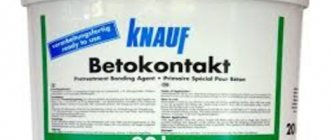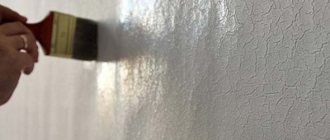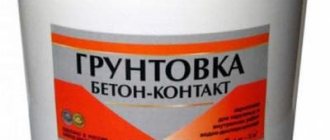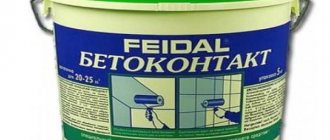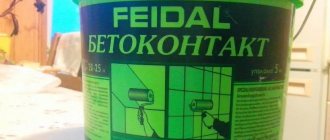Hello, friends! Recently I discovered such a material as Knauf primer: Concrete contact turned out to be ideal for smooth bases. Previously, I used tile adhesive on a non-absorbent surface, but now there is no longer a need. Thanks to Knauf, I forgot about the appearance of fungi, which could not be removed from the corner in the hall (the builders made a mistake). Adhesion has also improved, although it is necessary to remember the correct application technology. What to consider when getting down to business?
Specifics of using Knauf brand Betokontakt primer
The market has a wide range of mixtures:
- Easy to use;
- With a simple application system;
- With a low cost level.
The characteristics of a modern primer increase the strength and durability of the objects being treated.
The primer is suitable for working with:
- Horizontal structural objects of a room made of brick;
- Concrete surfaces;
- Vertical structural objects made of bricks.
The plastering process is accompanied by difficulties. They arise as a result of insufficient adhesion of mixtures applied to walls with a dry surface. Therefore, they are faced with the fact that recently laid plaster lags behind the walls. This is due to the fact that there is no normal adhesion between the material and the wall.
Rescue measures are taken, otherwise the plastering of the walls will be of poor quality. Pre-treatment is used, during which a special mixture - a primer - is applied to walls or other structural objects.
The Betokontakt primer from the Knauf brand is suitable for increasing the level of adhesion of walls that will be plastered.
Scope of application of Knauf products:
- Preparatory treatment of concrete bases before applying plaster;
- Working with polystyrene foam and plasterboard partitions before plastering these surfaces;
- In rare cases, work with the façade parts of the building and other exterior objects.
Knauf primer works best on smooth surfaces with a high density. Such conditions do not contribute to the formation of good adhesion, so Betokontakt is almost the only material option that can cope with this problem.
Review of the best concrete contacts
Concrete contact mixtures are applied to concrete, brick, wood, metals, glass, tiles, painted and whitewashed surfaces. For almost every type of coating, products are produced with slight differences in composition.
Solutions differ in price category. The presented rating includes primers from well-known manufacturers, manufactured in accordance with GOST and which received the largest number of positive reviews from builders.
Concrete contact Axton
High-quality dry mixture with the addition of marble chips is suitable for indoor and outdoor work. Add the amount of water required according to the instructions to the powder and mix the solution.
Used for rough substrates that do not need to be pre-cleaned. The consumption of Axton concrete contact is 300 g/m2, drying occurs in 3 hours.
Pros:
- does not require surface preparation;
- dries quickly;
- affordable price.
Minuses:
- increased consumption;
- it is necessary to prepare a solution from a dry mixture.
Review from Andrey, 39 years old : I primed plaster walls in the bathroom. This was my first time using this method and I regret not doing this before. Laying the tiles took me half as much time.
Betonokontakt Bolars
Betonokontakt Bolars is completely ready for use. Before starting work, you need to clean the surface from grease, dirt and dust. Average mixture consumption 300 g/sq.m. Shows excellent adhesion properties on the smoothest vertical walls.
With the help of Bolars, walls and ceilings are prepared for better application of gypsum, cement, and polymer solutions.
Pros:
- excellent adhesion quality;
- withstands harsh Russian winters;
- adequate price;
- does not require a second coat.
Minuses:
- surface preparation is required.
Review from Mikhail, 33 years old : I decided to conduct an experiment and lay new tiles on the kitchen splashback on top of the old one. The area is small, with the bolars everything worked out for me. Excellent concrete contact that saves money and time.
Betonokontakt Knauf
The unique composition of the primer mixture allows it to be used on any surface with different porosity parameters. Application density 1.4 kg/m3. The use of Knauf concrete contact increases surface tenacity, waterproofing and fire resistance, strengthens loose foundations, and removes microcracks.
Pros:
- universal application;
- does not require dismantling old coatings;
- resistant to alkaline compounds;
- economical consumption;
- eliminates microcracks.
Minuses:
- high price;
- requires care as it is difficult to wash off.
Review from Igor, 30 years old : We re-glued the wallpaper in the hallway. The walls were uneven, the plaster was cracked. Knauf primer easily and quickly covered the defects. The heavy wallpaper lays down clearly and the adhesion is excellent.
Betonokontakt Ceresit
Concrete contact st 19 is a safe product that can be used for any construction and repair work. The pink pigment allows you to control the thickness of the applied layer.
Significantly improves the strength characteristics of adhesion of vertical concrete surfaces to tile adhesive, cement-sand plaster, and other finishing materials. Ceresite concrete contact does not impair the ability of surfaces to transmit water vapor. The composition of the mixture is completely harmless to human health.
Consumption depends on the surface being treated, the approximate value ranges from 300-750 g per sq. m.
Advantages:
- very high adhesion;
- absence of hazardous chemicals;
- quick drying;
- acceptable cost.
Minuses:
- It is not always appropriate to apply a pigmented layer.
Review of Nikolai, 47 years old : Previously, when there was no such primer, it was impossible to putty on old concrete. This is not a problem now. I use ceresit concrete contact in the most difficult areas of finishing work.
Properties and capabilities of the Betonokontakt primer from Knauf
Knauf primer opens up wide possibilities for further wall finishing.
Its use will be useful in the following cases:
- Coating walls with paint, and it is possible to apply almost any dye without first removing traces of plaster;
- Gluing tiles on top of other tiles;
- Puttying metal surfaces;
- Gluing elements of stucco decor;
- Puttying ceilings, walls, etc.
This range of applications is provided by the technical characteristics inherent in this type of material.
Which is better: heated floors or radiators?
Warm floorBatteries
Knauf primer is characterized by:
- Quick drying;
- Ensuring a high level of adhesion between two bonded surfaces;
- Simple preparation;
- Ease of application, since specialized tools are not used;
- Increased resistance to moisture;
- Durability;
- Impermeable to water vapor.
The application mechanism in an abbreviated version looks like:
- Preparing walls or ceilings for priming.
- Diluting the mixture to the desired state, if required.
- Applying a layer of primer composition.
Composition and main characteristics
Concrete contact is a suspended solution based on acrylic, which includes purified sand, cement and specific fillers, including fungicides that prevent the growth of mold. The rough surface is created by a quartz filler with particles of 300-600 microns. The mixture has a high degree of adhesion due to polymer adhesives.
The basic composition of concrete contact includes:
- acrylic dispersion;
- quartz sand;
- cement;
- chemical modifying additives.
Various chemical composite additives that manufacturers add to their products give the primer layer the following properties:
- vapor permeability (allows the surface to “breathe”);
- hygroscopicity (perfectly absorbs moistened moisture, which is important when applying plaster or putty);
- resistance to mechanical influences (shocks, vibrations);
- resistance to biological interaction (prevents the appearance of mold).
Concrete contact is a harmless building material that does not harm the environment. Disinfecting components prevent the appearance of pathogens and insects.
Due to their neutral acidity, such solutions do not cause corrosion of metals and do not react with lime. Color pigments improve the visibility of primer application.
Important! Any type of concrete contact with a water-dispersion composition and acrylic copolymer must comply with GOST 28196.
Knauf primer consumption
The composition of the Knauf company has a pink tint. During the work, areas with the applied composition are visible, which ensures economical consumption of material.
Consumption depends on the type of surface being treated:
- The standard indicator is within 300 g/m2;
- Porous surfaces require an application of 300-500 g per 1 m2;
- Surfaces characterized by an average level of porosity require 200-350 g/m2;
- Smooth surfaces have a minimum material consumption of 150-250 g/m2.
After the layer of primer has dried, do not delay finishing the surface. The longer the break in work, the more dust will settle on the wall and the lower the adhesion rate will be.
Before priming, thoroughly clean the base, removing dirt, dust particles, and loose fragments.
To obtain a high-quality result, it is necessary that the moisture level of the concrete base does not exceed 3%. The optimal temperature for operation is +5-+25 degrees Celsius.
It is in this range that the temperature of the air, the treated surface and the Knauf primer should be.
The composition in the package is already ready for use. It is thoroughly mixed before use.
When applying Betokontakt by machine, it is recommended to dilute the solution. The proportion in this case is as follows: up to one liter of water is added to 20 kg of primer.
The solution is not diluted if a brush, roller or brush is used for application.
Objects that are characterized by a weak level of absorption are treated with a primer in one layer. Substrates with a high hygroscopicity index are coated in two passes.
The video shows the process of applying primer using a roller:
How to apply concrete contact?
It is more convenient not to mix this mixture yourself, but to purchase a completely ready-to-use solution in containers of 3, 5, 20 and 50 liters. When purchasing such a concrete contact, you will need to stir the contents of the jar so that the quartz filler is evenly distributed throughout the mixture. During the work, the primer is mixed several times.
There is a dry primer on sale that needs to be diluted with water. Do not exceed the amount of liquid, otherwise it will slightly reduce the adhesion of the finishing material.
Most manufacturers recommend removing grease, glue, bitumen stains, and areas that do not adhere well before starting work.
Cover the base with concrete contact once or twice, depending on the terrain. Before applying the next layer, the previous one must dry. For small volumes of work, use a brush or roller.
Professional builders resort to the help of spray guns. The possibility of using mechanical devices is specified in the instructions. In stores there is a version of the mixture in aerosol packaging.
To calculate how long it takes for concrete contact to dry, the following factors must be taken into account:
- number of layers to be laid;
- ambient temperature;
- relative air humidity.
If the weather is favorable, the drying time in the open air will be 2.5-4 hours. In an enclosed space, where the air is heated to +25℃ and the humidity is 65%, the wall will be completely ready for further work in 12 hours.
The service life of such a primer layer is 80 years. The optimal air temperature during work should not go beyond +5℃…+35℃, the recommended humidity is 60 – 80%. Concrete contact should not be used at subzero air temperatures.
Advantages of Knauf primer and other features
Advantages of Knauf primer:
- High level of quality;
- Reasonable cost;
- Simple and convenient to use; you do not need to have professional experience to do this type of work;
- Durable, reliable packaging;
- The composition is accompanied by instructions with a detailed description for the user;
- Environmental friendliness;
- No impurities that cause allergic reactions;
- Fast drying time.
The minimum time allowed for drying of the solution is 12 hours, provided the air humidity is 60% and the temperature is 20 degrees Celsius. To check the result, just touch it with your finger - the dry composition will not stick.
Betokontakt should not be used on surfaces characterized by friability and insufficient density. The walls should not be cold.
Consumption
This is the main point for such material. After all, it is very important to know in advance how much primer will be needed when treating surfaces. Taking into account the average cost of the material, which bites quite well, it will be possible to minimize the cost of purchasing soil.
Note that the accuracy of flow is influenced by certain factors:
- porous structure;
- smoothness;
- ability to absorb water.
It turns out that for a smooth surface less material will be needed. The average consumption per square meter is from 200 to 300 g. Let us clarify that these figures are relevant for the manual processing method. The use of a spray gun will increase the consumption.
Description of the product
The primer involves treating the top layer of walls (ceiling/floor) in order to increase the adhesion of materials. With the help of a primer, they create an even layer on which paint, glue, etc. lie evenly. At the same time, the consumption of the same paint will decrease, that is, the primer saves building materials and improves the final result.
Thanks to the penetration of the product deep into the pores, a protective, durable layer is created that prevents the formation of corrosion, mold and mildew. By tightly hiding small cracks and defects, Knauf primer mixture promotes a smoother finish. But despite the density of the primer layer, the surface “breathes”.
Properties of Tiefengrund
This mixture does not have a specific odor - a clear advantage for the application procedure. It does not emit harmful substances into the air, which makes it harmless to the human body. Tiefengrund mixture is used for a wide range of surfaces: plaster, brick, concrete, etc.
Why do you need concrete contact?
The main purpose of concrete contact is to ensure unconditional adhesion between materials while simultaneously strengthening the base.
The use of concrete contact is justified in many cases:
- before plastering surfaces with low moisture absorption (concrete, painted);
- treating walls before gluing wallpaper on any surface (brick, lime-whitened);
- use of rough, cracked, dusty walls before painting;
- to simplify work with tiles and glass;
- when installing a concrete screed, as well as under self-leveling floors.
After applying concrete contact, the finished surface will be a single layer of high strength. The finishing coatings will adhere perfectly to the base, will not crack, and will not crumble over time.
Concrete contact is an ideal replacement for labor-intensive banding of walls and ceilings. This method was widely used by builders and finishers in the Soviet and post-Soviet periods. Now you don’t need to nail or glue the mesh with PVA glue. The innovative primer solution eliminates the need to strip walls of old coatings without compromising quality.
Important! When the composition dries, it forms a waterproofing layer, which makes it possible to increase the safety of plastered surfaces in winter. Under the concrete contact layer, the plaster will remain intact until spring.
Scope of application and primer consumption from Knauf
The primary purpose of the Tiefengrund product is the treatment of walls/ceilings before finishing work. The purpose of its use is to increase the ability of the base to firmly adhere to the base and the desire to reduce the consumption of the same paint. Knauf Tiefengrund primer is used for subsequent painting of walls, laying tiles on walls/floors, wallpapering or puttying.
It is allowed to use Knauf even on top of gypsum moisture-absorbing plaster, gypsum plaster boards, and it can also be combined with self-leveling floors. That is, even on surfaces prone to self-destruction, the primer creates a durable film that does not interfere with air exchange. This soil is used both inside buildings and for exterior finishing activities.
Material consumption when applying one layer is from 0.07 kg to 0.1 kg per 1 sq. m. In addition to 10 liter packaging, 5 liter buckets are also produced.
Instructions for using concrete contact
Working with polymer-sand primer for smooth surfaces is easy. For manual work you will need:
- ready-made concrete contact solution or dry mixture for self-preparation;
- roller with a long handle for covering walls or floors;
- wide brush for working corners;
- tray for rolling out the solution.
For faster work, the only tools you need are a spray gun.
Stage 1: preparation
For new surfaces, removing traces of formwork and degreasing is sufficient if lubricants were used to remove the form. It is also necessary to get rid of traces of bitumen and dust deposits.
To work with indoor concrete contact, it is necessary to create optimal temperature conditions of +5°...+30°C according to the instructions. However, it is recommended to coat the walls at a temperature of about 20° - this way the solution adheres better and does not set prematurely in the tray and on the brush (roller). The room should be well ventilated to normalize the humidity level.
Stage 2: application
How to apply concrete contact with a brush and roller:
- they start working from the corners - they are painted over with a brush in the same way as with paint;
- It is convenient to cover the main area with a roller, dipping it into a tray with primer, rolling out the remains on the grate and applying the product to the walls.
When applying manually, the solution in the bucket must be stirred periodically - grains of sand settle at the bottom of the container.
Before loading the concrete contact into the spray gun, it is necessary to add 0.05 liters of water per 1 kg of soil to obtain a working consistency. The emulsion should be applied at a time, continuously covering the entire wall, floor or ceiling.
Advantages of Knauf Tiefengrund primer
Strengths of quick-drying Tiefengrund:
- A colorless substance with no foreign odor.
- Does not emit caustic substances, absolutely harmless.
- The primer contains no solvents.
- A 10 kg package is enough for 100 m².
- Production is carried out with constant internal and independent control. The product has received a certificate in accordance with GOST R.
- Strengthens the base.
- Increases adhesive properties.
- Dries quickly.
- Supports air exchange.
- There is no isolation of water vapors.
- Saves finishing materials.
- Withstands temperature changes and changes in humidity levels.
Soil characteristics
Knauf primer is available in two types: one modification contains mineral particles measuring 0.3 mm, and the other - 0.6 mm. The first is used for delicate work and before puttying, and the second is more suitable for rough finishing. The dye included in the composition helps not to miss a single area during processing.
According to GOST, the technical characteristics of the Knauf concrete contact primer are as follows::
- Neutral acidity index Ph 6.5−7.5.
- Short drying period. It depends on the humidity and temperature in the room, but usually no more than 10-12 hours.
- Long service life. The manufacturer claims that the primer applied to the walls can last more than 50 years.
- A wide range of temperatures (from -20 to +60 degrees) at which concrete contact does not lose its properties.
- Uniform application. The mixture fits perfectly on walls both when applied manually and when sprayed with a spray bottle.
- Highly environmentally friendly. The adhesive primer can be safely used in rooms with insufficient ventilation, since the chemical formula of the substance does not contain toxic compounds that can harm health.
Technical characteristics of the Knauf Tiefengrund primer
The product is manufactured according to the original formulation of German manufacturers and complies with European quality standards (DIN 55947).
Technical characteristics of Tiefengrund:
- Matte shine.
- No smell.
- The film is transparent, colorless.
- The product has penetrating properties and high adhesive qualities.
- Bonds and impregnates materials up to 10 cm deep.
- Vapor permeable, does not retain water vapor.
- Environmentally friendly substance.
- Drying time – 2 hours.
- It can be stored for up to 10 months – 1 year.
When working, the product is diluted with water up to 50%. Before priming, carefully prepare the walls so that material consumption is minimal. The base is cleaned of dirt, grease and dust, and dried. If there are flaking and crumbling particles on the ceiling, floor, or room walls, remove them.
The first step is to carry out test smears to determine the appropriate level of dilution with water. This is explained by the different structure of the materials. For drywall, one coat of primer is enough. The manufacturer does not recommend using Tiefengrund on oil-adhesive putty walls.
A construction brush or roller is used as a tool to help evenly distribute the soil over the surface. Sometimes the substance is sprayed. After the first layer, apply the next one immediately, without drying, but be sure to monitor the consumption. You cannot overuse the material, as this can lead to “glazing”. The composition is diluted with water no more than 1:1, that is, the maximum amount of water per package of soil (10 l) is equal.
The mixture is stored in a tightly closed factory container at above-zero temperatures. Freezing the product is under no circumstances allowed!
